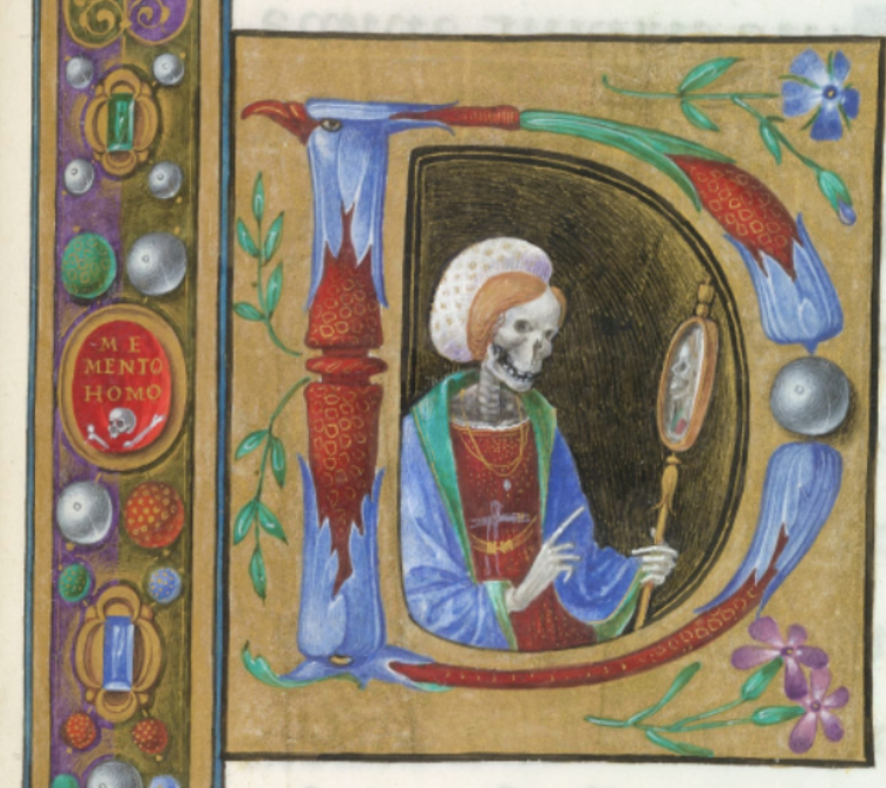Medieval Body: Bone
When we consider bone in the Middle Ages, we are met with our most enduring image of a personified Death. Long before the grim reaper, Death was a skeleton, a dancing figure whose image ranged from the macabre to the comedic. The image depicted here shows three skeletons, one clothed with worms covering the garment, another shrouded, and a third standing without clothing and looking straight on at the viewer. The green background is replete with small flowers and gives the sense that the skeletons are encased by the earth. Many medieval images of skeletons show them with a large toothy grin, which seems a bit funny now but probably was unnerving to behold.
Detail of a miniature of the Three Dead from the the 'De Lisle Psalter', England (London?), c. 1308-c. 1340, Arundel MS 83, f. 127r
This week students are reading a translation of La Danse macabre "The Dance of Death," [1] a French poem which was based on a mural at L’Église aux Saints Innocents (the Church of the Holy Innocents) in Paris, constructed in the summer of 1424/5. The illustrative panel at the Church of the Holy Innocents is no longer extant, but it depicted various people of different social stations meeting death (i.e. the dance). The word macabre is interesting, too. Some scholars think it is from Arabic (“maqābir” meaning “graveyards”) or Hebrew (“m’kaber” meaning “undertaker”), while others note that in early French literature it may refer to the name of a person, probably sometime in charge of caring for the dead, Macabré. Others link it up with Judas Maccabæus, and the "dance of the Maccabees".
Regardless of the word's origin, La Danse macabre continues the tradition of the image-text by staging a dialogue between the personified Death and various people in society. One of my favorite dialogues in this poem is between Death and the Physician, a person trained in medicine and natural philosophy whose job it was to stave off death for their patients. When Death comes for the Physician, he says:
Medecin, a tout vostre orine Physician, in all your urine
Veez vous ycy qu’amender? Do you see here what to cure?
Jadis seustes de medicine You once knew enough
Assez pour povoir commander, About medicine to be able to prescribe treatment,
Or vous vient la mort demander. But now Death comes to ask for you.
Comme aultre vous convient mourir. You must die like any other.
Vous n’y povez contremander; You cannot countermand it:
Bon mire est qui se scet guerir. The good doctor knows how to cure himself.
(ll. 351-358)
Death taunts the Physician, knowing that the doctor has no power over his own, final death. While the Physician's station in life is to cure others, he cannot revoke death's power over his own body. The Physician responds to Death's command:
Longtemps a qu’en l’art de phisique For a long time I devoted myself entirely
J’ay mis toute mon estudie. To studying the art of medicine;
J’avoye science et pratique I knew both the theory and the practice
Pour guerir mainte maladie. Of curing many an illness.
Je ne scay que je contredie: I do not know with what to counter:
Plus n’y vault herbe, ne racine, Plants and roots and other remedies
N’autre remede. Quoy qu’on dye, Are no longer any good. Whatever they say,
Contre la mort n’a medicine. There is no cure for Death.
(ll. 359-366)
No plant, no root, no art, theory, or practice can cure Death. While other dialogues focus on worldly goods, such as the Bishop who is fussed he won't be able to wear his squirrel fur any longer, the discussion between the Physician and Death really highlights the truism that death comes for us all.
Detail of an initial in the Office for the Dead, from the Hours of Dionora of Urbino, Central Italy, c. 1480–1520, Yates Thompson MS 7, f. 174r
Despite all of the Physician's studying, he is not versed in the "art of dying," known in Latin as ars moriendi. This tradition asks people to learn how to live well so that they may die well. In other words, the practice of dying well is something that one does daily in one's life, and should not be kept as something to learn at one's deathbed. As the Sergeant says to Death: "Envis meurt qui aprins ne l’a" (He is loath to die who has not learned to die well). A similar tradition was known as memento mori, the reminder of the inevitability of death. This motif is typically presented in medieval art as an individual holding a mirror, only to see a skeleton looking back. This image shows a detailed initial of a "D" in the Office for the Dead, from the Hours of Dionora of Urbino, c. 1480-1520. I love how the illustrator doubles-down on that idea, asking the viewer to memento homo, "remember humanity," written in a red circle on the left side (underneath is a skull and bones).
We have so many representations of death in modern media today, I think about tarot cards (a medieval thing!), the "Tale of the Three Brothers" from Harry Potter (based on Chaucer's Pardoner's Tale!), the film Meet Joe Black, and all of the grim art that decorates gravesites. Our cultural conceptions of death emerge in the images that we form of death and how we personify Death, in some attempt to explain the inexplicable.
[1] La Danse macabre, translated by Elizaveta Strakhov in John Lydgate's Dance of Death and Related Works, eds. Megan Cook and Elizaveta Strakhov. (2019)

